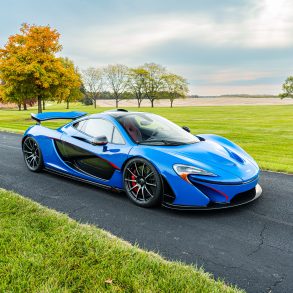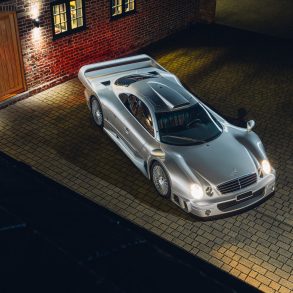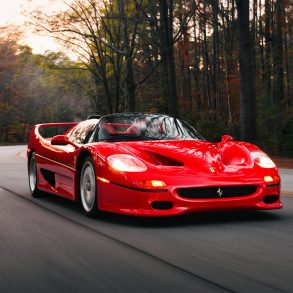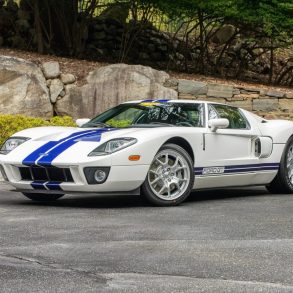Heavens To Murgatroyd! – Big surprise at the 1969 24 Hours of Daytona

If you had attended the 1969 24 Hours of Daytonaor had read about it in your local paper the following Monday the results of that event might have elicited a phrase such as Heavens To Murgatroyd!
While that phrase might not be familiar to today’s younger generation, it was certainly familiar to young people in 1969 who might have been fans of the Yogi Bear TV show or to their parents who were familiar with a 1940’s era movie star by the name of Bert Lahr. His best known role was that of the Cowardly Lion in the classic movie The Wizard of Oz.
On the track that Sunday afternoon when the checkered flag dropped at 3:08 pm the comments wouldn’t have been as mundane. I won’t repeat in this publication what I overhead that day since this is a family-friendly publication.
This was a race that saw the unexpected happen. The mighty Porsche factory team that finished 1-2-3 at Daytona in 1968 would see all five of their Porsche 908’s fail to finish. The two Ferrari-killing Ford GT40’s of John Wyer Automotive also failed to finish. The winning car that outlasted these titans was the Eric Broadley-designed Lola T70 Mk. IIIB entered by Roger Penske and driven by Mark Donohue and Chuck Parsons. Another Lola T70 Mark III came in second and this one was entered by none other than actor James Garner and his American International Racers (AIR) team. An ACTOR! Who would have “thunk” it?
I think I am getting ahead of myself in telling this story. It all started out normally enough in 1969. There was the annual migration in late January of racers and sports car fans to Daytona Beach for the first big international endurance race of the year, otherwise known as the 24 Hours of Daytona.
On the beach side of the city of Daytona the main artery, known as A1A, was clogged with exotic automobiles like Ferraris, Alfas, Cobras, and Lancias with a sprinkling of MG’s, TR4’s and the usual assortment of domestic iron from Ford and Chevrolet.
The race fans driving some of those “furrin” cars were quite different from the race fans who normally come later for Speed Weeks and the Daytona 500. These “Furriners” and “Yankees” sported longer hair and sideburns and wore what some called modish fashions. There were also the young women with their long hair, short skirts and boots. And some of them even wore cut-out dresses that exposed great expanses of the female anatomy. No doubt more than one resident senior citizen had to be treated for neck problems. Why? From all the head twisting and turning in an attempt to get a better view of the young ladies walking by the tourist shops and head shops on Main Street.
At the Daytona Speedway in the last week of January the infield was already filling up with every imaginable kind of van, trailer and tow vehicle. Racers and course workers alike were already staking out a spot for their rental trucks, cars, tents, canopies and other equipment.
Those on a limited budget (which included many racers, fans & workers) either planned to sleep in their cars for several days or slept outside in sleeping bags placed on aluminum lounge chairs. This could present a problem for some because Daytona in January and early February can get a little chilly. Thick damp fogs have been known to roll in off the Atlantic Ocean making life miserable for all concerned and racing on the track extremely dangerous.
The talk at the track in 1969 was whether Porsche would repeat its 1-2-3 finish from the previous year and prospects for this looked good. The factory had brought over five Porsche 908L’s that were only slightly different from the previous year’s winners except with larger engines (2.2 to 3-liter) and different spoilers. The “L” designation (some prefer LH) stood for Langheck or long tail. Porsche had experienced problems with the shorter body 908 when at speeds in excess of 190 mph the tail began to lift. The longer body and new rear spoiler gave them the downforce needed to correct that problem at high speed tracks like Daytona and Le Mans.


1969 24 Hours of Daytona – Race Profile Page Two
If you believed the automotive press at the time the only competition that Porsche was supposed to have at Daytona was the two five-year-old (ancient by racing standards) Ford GT40’s entered by John Wyer of JW Automotive of London. Ford had been very successful in challenging Ferrari and Porsche for the manufacturer’s championship and won the 1968 trophy literally in the last points event of the year at Le Mans.
Where was perennial winner Ferrari? The Italians were noticeably absent from Daytona because Maranello was still having problems with their new three-liter sports prototype, the 312P. The French Matra team was present with the Matra-Sports 630M but few gave the car a chance of lasting the grueling 24-hour event. The general feeling about the French racer was that the car was fast and pretty but usually didn’t last. And it didn’t. Driver Henri Pescarolo flipped the Matra during night practice destroying the car. He walked away with bruises.
Rounding out the field of prototypes were four Lolas. Two T70 Mark III’s from James Garner’s American International Racers driven by Ed Leslie, Lothar Motschenbacher, Scooter Patrick and Dave Jordan. One T70 Mark IIIB from Sports-Car Unlimited driven by Jo Bonnier and Ulf Norinder and a T70 Mark IIIB from Roger Penske/Sunoco and driven by Mark Donohue and Chuck Parsons. During qualifying the Penske Lola managed to place second on the grid with a speed of 121.704 mph. The works Porsche 908’s were first, third, fourth, 6th and 7th on the grid. The Bonnier Lola was gridded 5th and the JW/Gulf GT40’s driven by David Hobbs, Mike Hailwood, Jacky Ickx and Jackie Oliver were gridded 8th and 9th.





1969 24 Hours of Daytona – Race Profile Page Three
At approximately 3 pm on Saturday, February 1, 1969, the green flag dropped on the 63 cars entered in the race and the five works Porsches plus the Donohue and Bonnier T70 Lolas began distancing themselves from the rest of the field. Each of the white works Porsches had a colored panel to help identify the car at a distance and the panel even glowed in the dark. During those early hours of the race the Porsches swapped the lead so many times that the scoreboard operator had trouble getting the changes quickly enough before the positions changed again. It looked like a repeat of the 1968 finish was in store.
For Penske the promise of having one of the fastest cars on the track and possibly winning this event faded quickly due to a serious fuel pick-up problem. The pump system could only pick up 20 of the 37 gallons in the tank and this necessitated having to pit every 40 to 45 minutes, twice as often as planned.
Later Mark Donohue, an engineer, admitted the fuel problem was all his fault. He said: “I engineered the fuel system myself and I take full blame.” Despite these problems the Penske Lola pressed on, but fell further and further behind the leaders.
Sometime around the 84th lap one of the leading Porsches unexpectedly pitted. Driver Brian Redman had noticed exhaust fumes entering the enclosed cockpit and he managed to pull into the Porsche pits before he passed out. A broken exhaust manifold was the problem and the Porsche mechanics took over 20 minutes to replace it.






Before darkness fell over the Speedway the Jo Bonnier T70 Lola would retire after hitting the wall on the the high banks, an Alfa Romeo T-33 driven by Mario Calabattisti would hit the wall in turn one and spin into the path of the Porsche 911 of Peter Gregg. The resulting impact flipped the Alfa over with the Gregg Porsche on top. A fire started that consumed the Alfa. Gregg was uninjured but Calabattisti suffered head, knee and hand injuries. While all this was going on another works Porsche would pit with exhaust problems.
By one o’clock on Sunday morning the two Ford GT40’s were now in the lead as problems continued to plague the remaining three works 908’s. Even the Penske Lola had to pit twice for welding repairs on cracked exhaust manifolds that took 90 minutes to fix. Plus a jammed starter took another 23 minutes to sort out. And let’s not forget the continuing fuel pick-up problems. There was some talk in the Penske pits of retiring the car because they were many laps and many miles behind the Fords and Porsches but Roger Penske persevered and ordered the repairs.
To add insult to injury the Penske Lola made contact with the #51 Richard Attwood/Joe Buzetta works Porsche 908 on the track causing a pit stop for body repairs (mostly using duct tape). Also in the pits was the leading Ford GT40 driven by David Hobbs and Mike Hailwood. Their problem was a cracked cylinder head which was causing a loss of coolant and eventually led to their retirement.
1969 24 Hours of Daytona – Race Profile Page Four
At 5:20 am one of the works Porsches retired with a blown engine. The remaining Ford GT40 was now in the lead but drivers Jacky Ickx and Jackie Oliver wouldn’t have much time to enjoy it because their car was also suffering from a cracked cylinder head. Their retirement came in spectacular fashion when at 7:35 am Ickx spun the car into the concrete retaining wall on the front straight. The fire that followed eliminated the car but Ickx escaped unhurt.
As the sun was coming up on the Daytona Speedway the remaining works 908 assumed the lead with the Penske Lola in second place some 200 miles behind the leader. The Porsche lead didn’t last long and they pulled into their pits with a blown intermediate shaft. The collapse of the five factory Porsche 908’s came in deadly order at 12:15 am, 12:25 am, 2:58 am, 5:20 am and the remaining Porsche 908L of Gerhard Mitter and Udo Schutz retired at 7:50 am.





1969 24 Hours of Daytona – Race Profile Page Five
With the retirement of the factory Porsches and JW Automotive Ford GT40’s, the Roger Penske Lola T70 Mk. IIIB of Mark Donohue and Chuck Parsons will eventually inherit the lead if they can just hold the car together. This was a stunning turn of events for everyone watching the race and there were plenty of folks shaking their heads in amazement.
And that’s the way it was for the very tense five remaining hours of the race. When you consider what transpired during the race to bring the Penske Lola down pit road and into the winner’s circle it was an incredible turn of events and a lucky and well-deserved win for the Penske team. This win graphically showed that Roger Penske and company were more than a match for John Wyer and the JW Automotive group. Drivers Mark Donohue and Chuck Parsons covered 2,383.75 miles with an average speed of 99.268 mph.
The AIR Lola T70 Mark III of Ed Leslie and Lothar Motschenbacher finished second, 30 laps behind the winner, much to the delight of actor and team owner James Garner. The Pontiac Firebird 305 of Jerry Titus and Jon Ward finished third, 35 laps behind the winner, but first in class The best Porsche could do was 4th with a private entry 911T driven by Tony Adamowicz, Bruce Jennings and Herb Wetanson.




In March of that year Penske entered the Daytona winning Lola in the 12 Hours of Sebring but they failed to finish due to a rear suspension failure. The notoriously rough Sebring airport course had claimed another victim. Despite this setback Penske and Donohue were already planning for an assault on the Holy Grail of endurance racing, the 24 Hours of Le Mans. Both men returned to Penske HQ in Philadelphia to start the planning for the trip to France.
Le Mans wouldn’t be in the cards for the Penske team in 1969 and the reason had nothing to do with racing. It had everything to do with good-old-fashioned car theft.
While most of the Penske crew returned home, two were assigned to trailer the Lola back to Philadelphia. They made an overnight stop in Daytona Beach for what they considered was much needed R&R. When they awoke the next morning the truck and race car were gone. Yes, stolen right out of the hotel parking lot while the crew members were “resting.”
An alert was immediately sounded. The newspapers headlines read “Top Lola Stolen in Daytona Beach, 2 Engines and Parts Worth $35,000 Are Missing.” Later the purloined truck was located just west of Daytona Beach. Unfortunately the race car and related equipment in the truck had been picked clean. In the process of removing the engine and other parts from the Lola the thieves had literally chopped the car and frame to pieces. In other words they butchered it. As a result Penske and Donohue were forced to abandon their trip to France.
A few weeks later a tip led the police to the place where they supposedly would find the missing items. Mark Donohue was even allowed to accompany the police on the raid. After the police arrested the miscreants they found that the thieves were in the process of installing the Lola engine into a Shelby Cobra.
The win by the Penske team at Daytona in 1969 would be the only major international victory for the T70. Within weeks of the Daytona race Porsche would unveil its legendary 917 race car at Geneva. The world of endurance racing would never be the same.
[Source: Photo credit: Louis Galanos and Fred Lewis]











Thanks for the Christmas present…lovely story and pictures.
Wonderful story….certainly much better detailed with insight compared to Road & Track reports of the day….which usually came 3 months later in the mail !
A couple of things.
1.) Heavens To Murgatroyd!….Wasn’t that Snaggle-Puss?.”Heavens to Murgatroyd…exit…stage left!”
2.) More correctly, John Wyer’s operations were in “Slough”, not really in London.
3.) Pretty much the full armada of the 5 908’s suffered the very same intermediate shaft failure. I believe it was team manager Rico Steinemann ( taking over from long-time Baron Huschke von Hanstein) who was supposedly quoted as saying..”I guess Porsche does not make very good intermediate shafts. These are some of the reasons Porsche goes racing, to improve components. ” In fact, I think these were aluminum and were indeed later changed to steel. Hmm…even spin doctors back then !
Thanks for such a vivid account of the race, told as only someone close to the sport could. My earliest racing memories were about the same time, so it’s great to hear trackside reports like this. Photos are great, but the words are king!
Enjoyed reading the story, and always like photos from you and Fred.
Thanks
Ed
Great summary of the events that took place, it caught us all by surpise that the Porsche or the Wyer GT40’s did not finish….
Louis,
It is really an amazing article for a great race with an incredible field. I could not stop reading the story before the end. The photographs are gorgeous, as the cars are too.
Congratulations and thanks for that.
Many thanx Louis for this piece of history !
Hope another will come.
Thanks for a great story, and great photos (esp ‘hello’ to my friend Fred Lewis)This was the golden era of sports car racing.
Another great Louis Galanos story. Fabulous details and pictures. Between you and Fred, there are some great shots. Thank you for writing it, and for Sports Car Digest for playing Santa and delivering this, just in time for Christmas.
But I think Will Ferch is right about Heavens To Murgatroyd!
Exit – stage left
Cheers
Another fantastic return to the great years of “sports car racing”. With your descriptive writing, you could omit the photos….. But don’t you dare !
Mario
Yes, I remember reading the Philadelphia newspaper sports pages on the Monday after the race and being amazed at the victory.
I may have said this before, but I think this particular victory did a lot for the reputation of Penske racing-it was against a strong field in an event with a big international reputation.
For me, it was impressive as it was a LeMans-type race against cars that I was well familiar with from slot car racing!
In the 60’s I vacationed in Florida in March to attend the 12 hours of Sebring. However, in 69, my wife was expecting our firt child and the Doctor ruled out traveling in March. However, the Doctor approved traveling earlier so we attended the Daytona 24.
We didn’t rent a motel so we slept in the car that night. The wife made it through the night just fine and cheered her favorite driver to victory the next day.
Therefore,the article brings back a fond memory.
Bill
Thanks Bill. I am curious about one thing. Since you have taken your share of nice race photos yourself I wonder what you would have done if your wife had gone into labor during the race. Would you have dropped her off at the track physician and continued photographing the race, or??? :-)) Happy Holidays
Bill:
That anonymous comment is from me (forgot to list my name). My wife said you might not take it as a joke so no offense intended. Best wishes.
Louis,
No offense. We both thought your comment was quite humorous as we look back on it now. She says that the back set was not very comfortable.
I’m looking forward to more articles to be able to relive memories.
Louis and Fred have done it again. Great article. Spectacular pictures. What a treasure you all have tucked away. I hope you all will get more published. Next let’s hear about the ‘water in the fuel’ BMW CSL win with Gregg, Redman and Fitzpatrick.
Another great article from SCD and the photos were fabulous. Kudos to the author and photogs. Hopefully there will be more from the author in the future.
Small world, isn’t it, because of the ‘net? Thanks for the kind words from e-mail pals Ed, Nathan and Arthur. I had the pleasure of meeting Lou and Wilma at Daytona in November. As a retired teacher I assumed Lou’s subject was English since all his stuff is so well written. No, Wilma was the English teacher and she proofs the articles, he said. Having good material makes proofing easy, I’d think. And, probably entertaining for Wilma since she was there as a corner worker along with Lou. Two sets of memories can make for more details to enhance readers’ enjoyment of remembering what it was like then.
Marvelous job by all. Is it just me or is that a really fast Ford station wagon in the pace lap photo? Ha.
Noticed that too ! ha ha
Very interesting article, congrats for it and for the photos!
As always, excellent ! Limpid text and original pictures, thank you !
A great story from a great era in sports cars and motorsport. I have a great fondness for endurance racing and stories like this preserve it for later generations to enjoy.
Thanks for the article , it brought back many memories of those awful looking Porsche 908L , I was rooting for the GT40’s or anyone else for that matter….I am glad they designed the 917 they really did a great job with the design maybe they fired the 908L design crew…
Jorge: If memory serves me correctly the design of what we remember the 917K looked like was a result of stealing design ideas from Eric Broadley’s Lola T-70 Mk.IIIB and then having John Wyer Automotive adapt and improve on those ideas. The Ferrari factory stole design ideas from both the Lola and 917 for their 512M. Alas, it was too late to help Ferrari win the championship. If they had had only one more year.
Lou,
Great Article! I enjoyed it very much and the pictures were great…one of ‘the Captain’s’ best victories.
My father’s (Jon Ward) car, is pictured. I remember the stories my brother told me of running and dragging a floor jack around the parking lot in the middle of the night looking for a late model camaro to steal a rear end out of! They found one (luckily the right gear ratio) and left the car on stands with a note. Everyone burnt their hands getting the failed rear end out (apparently it was nearly glowing red) and the whole process took about 45 minutes.
Thank you Louis and Fred !!! Wonderful story and photos !!
This was the first race I ever attended, thanks to my incredible father. I was immediately awestruck, and knew then and there that i would race cars….and I did, even at Daytona. So wonderful memories for me, and thanks again to Louis and Fred ,and SportsCarDigest for publishing this about a GREAT era of racing.
Louis, also thank you for the 1970 Sebring 12 Hour video…..fabulous !!!! Was there as well…what memories
The lines of the cars from that era remain the most beautiful today…
Thanks for the “reprint”.
The race articles with great photos by lou Galanos are always a pleasure to read and re-read
.